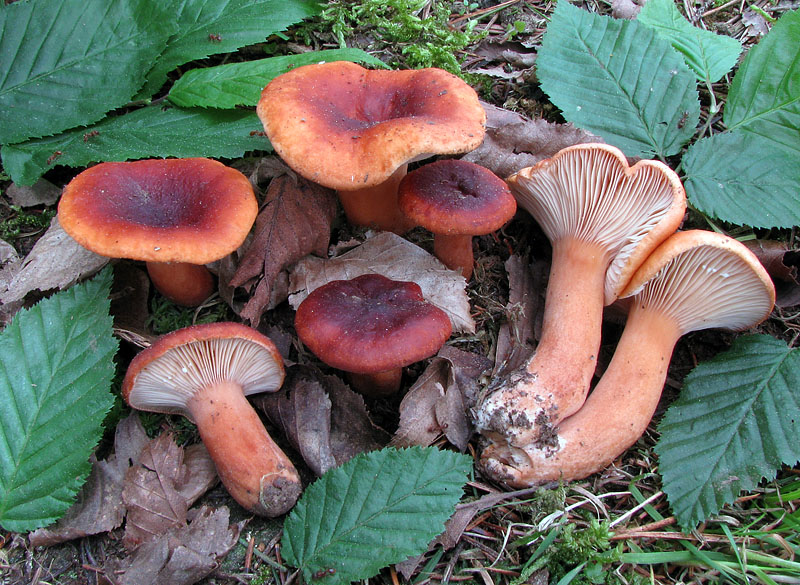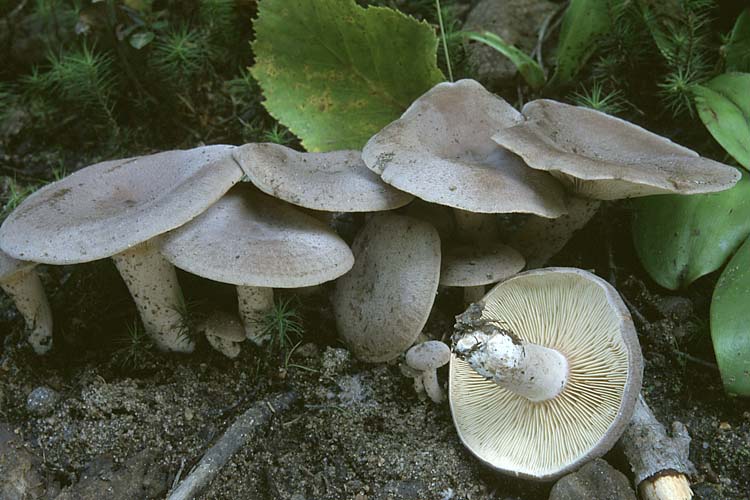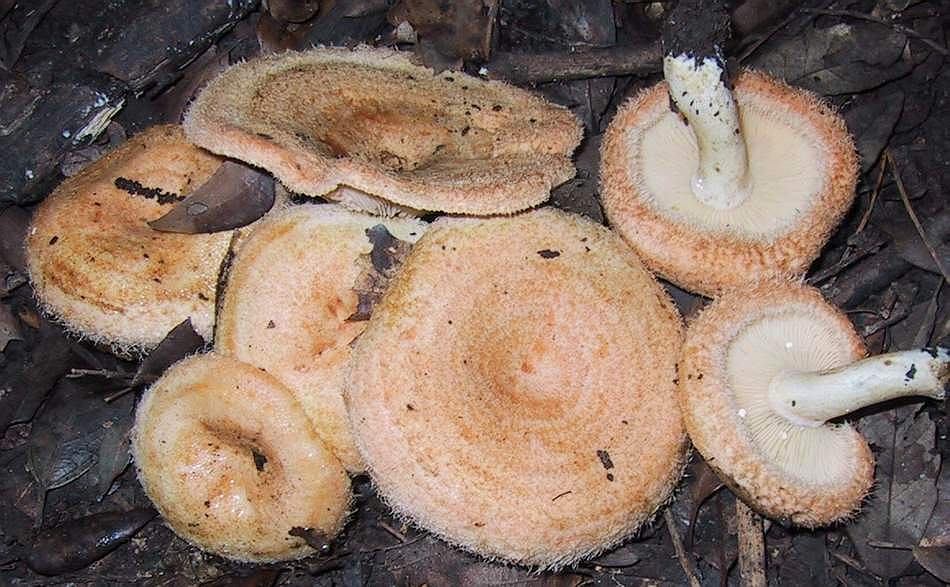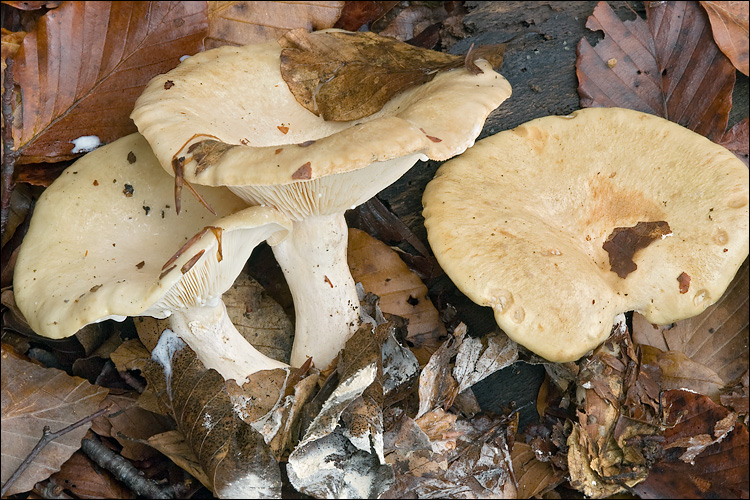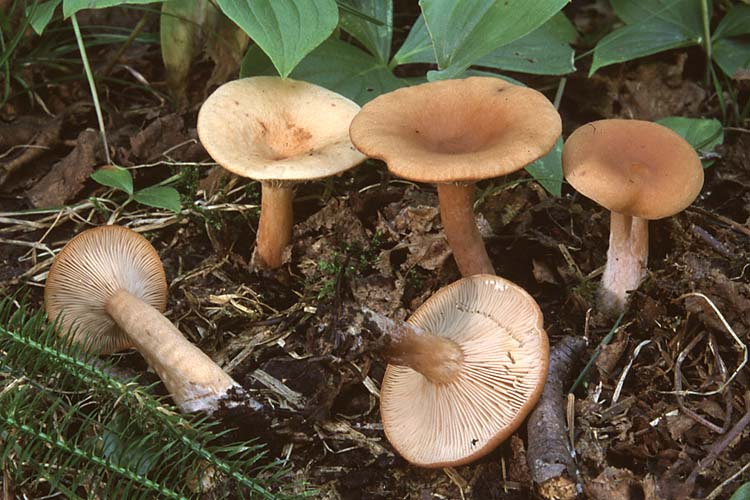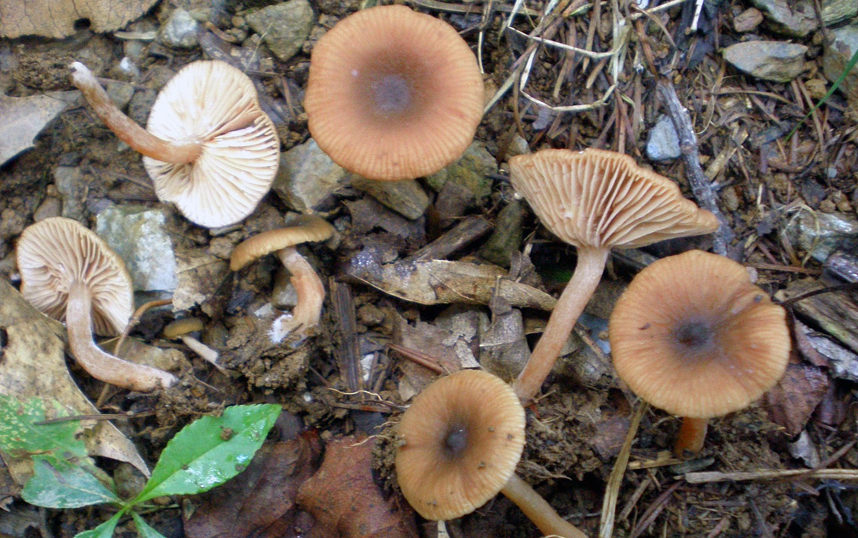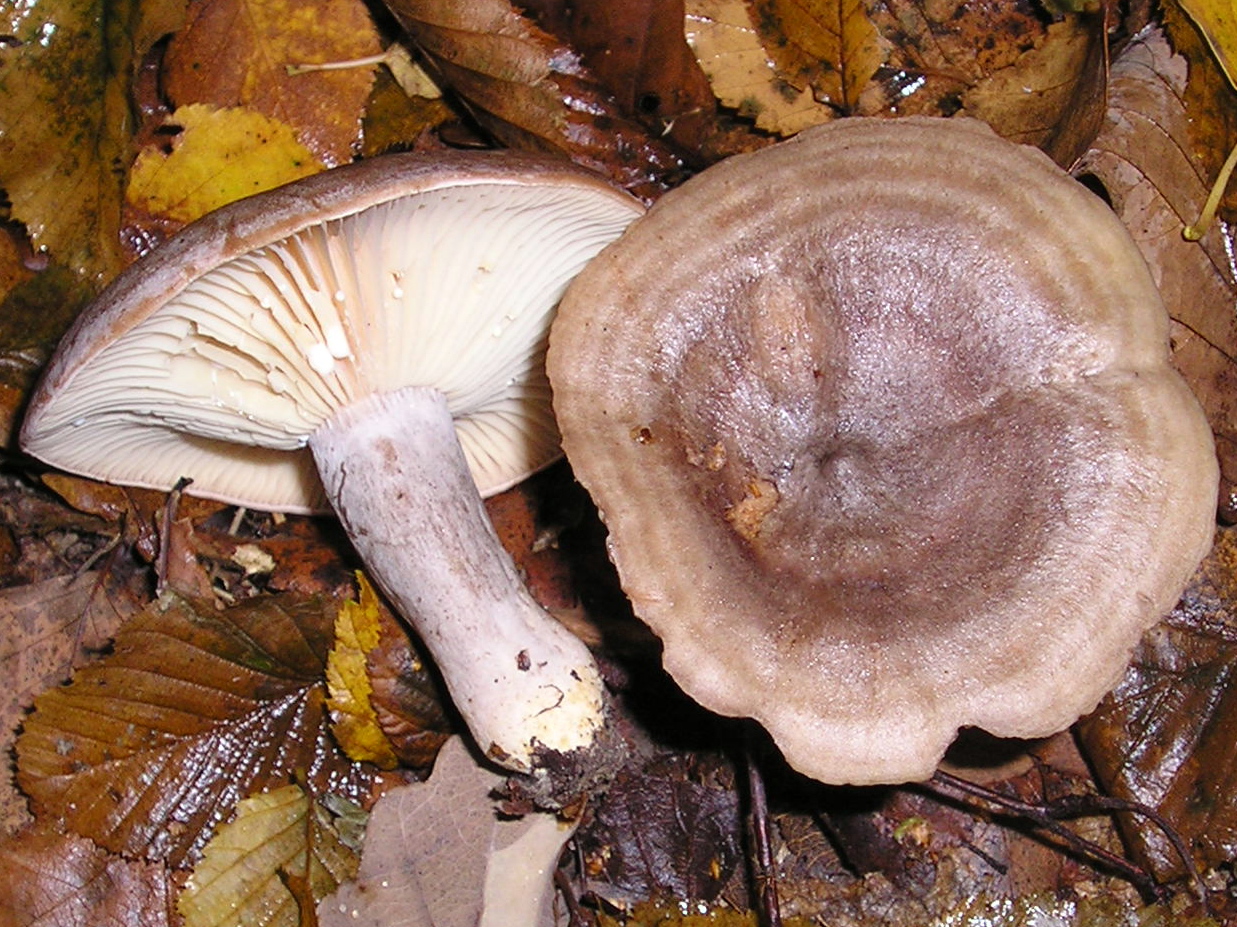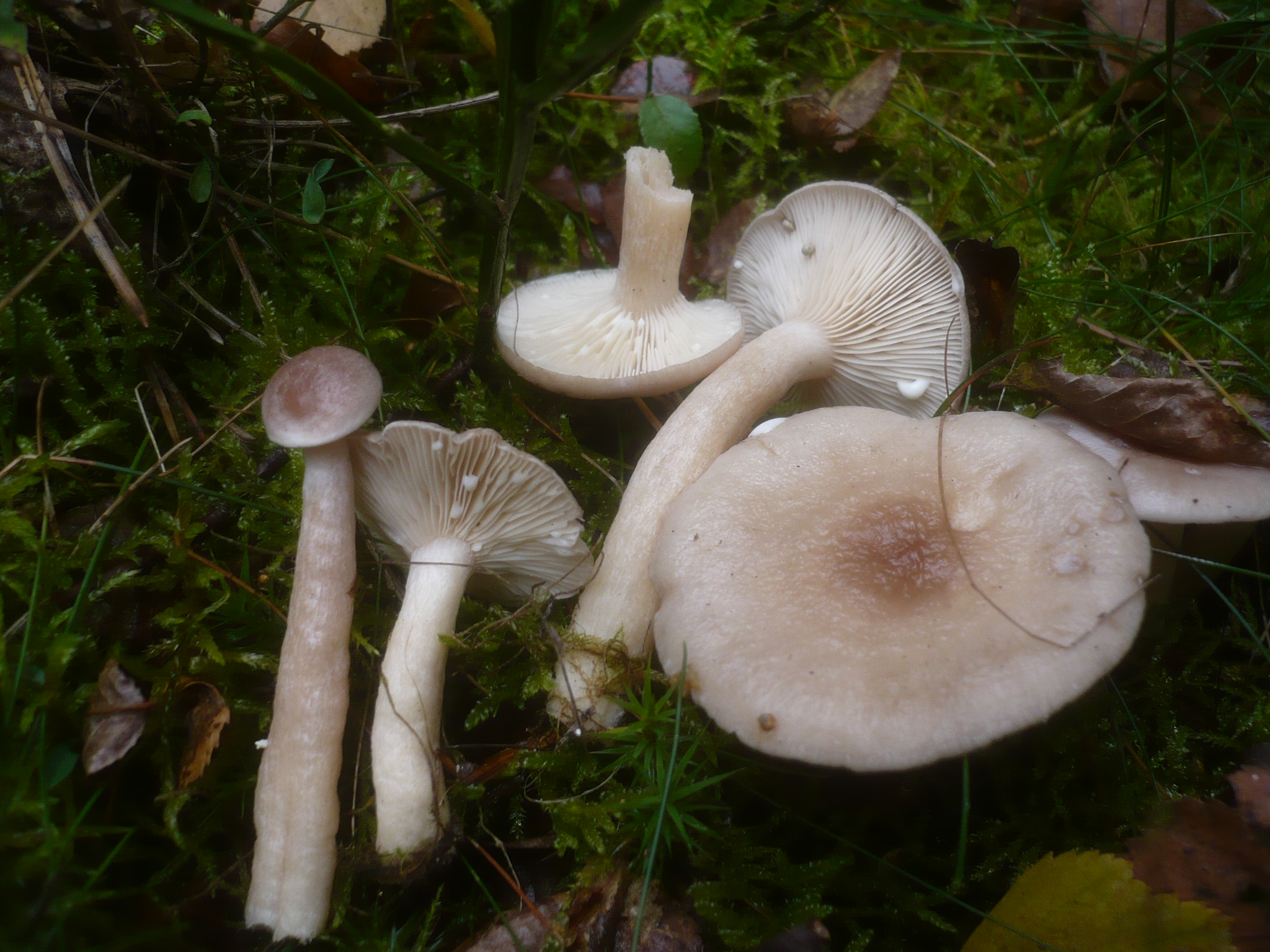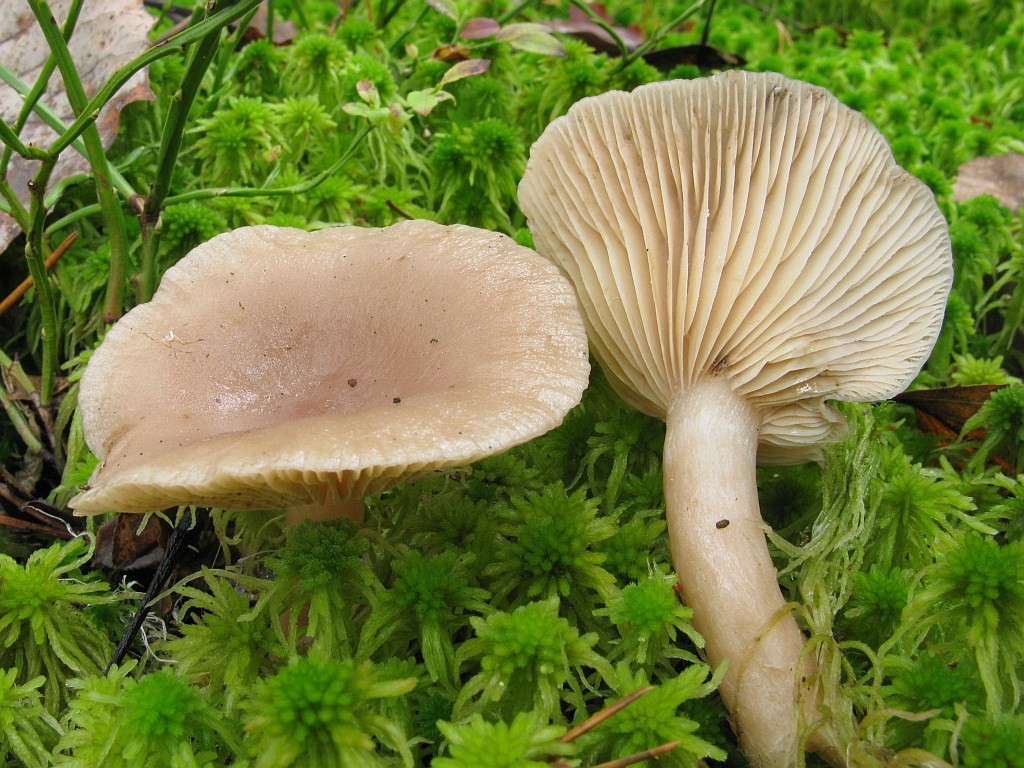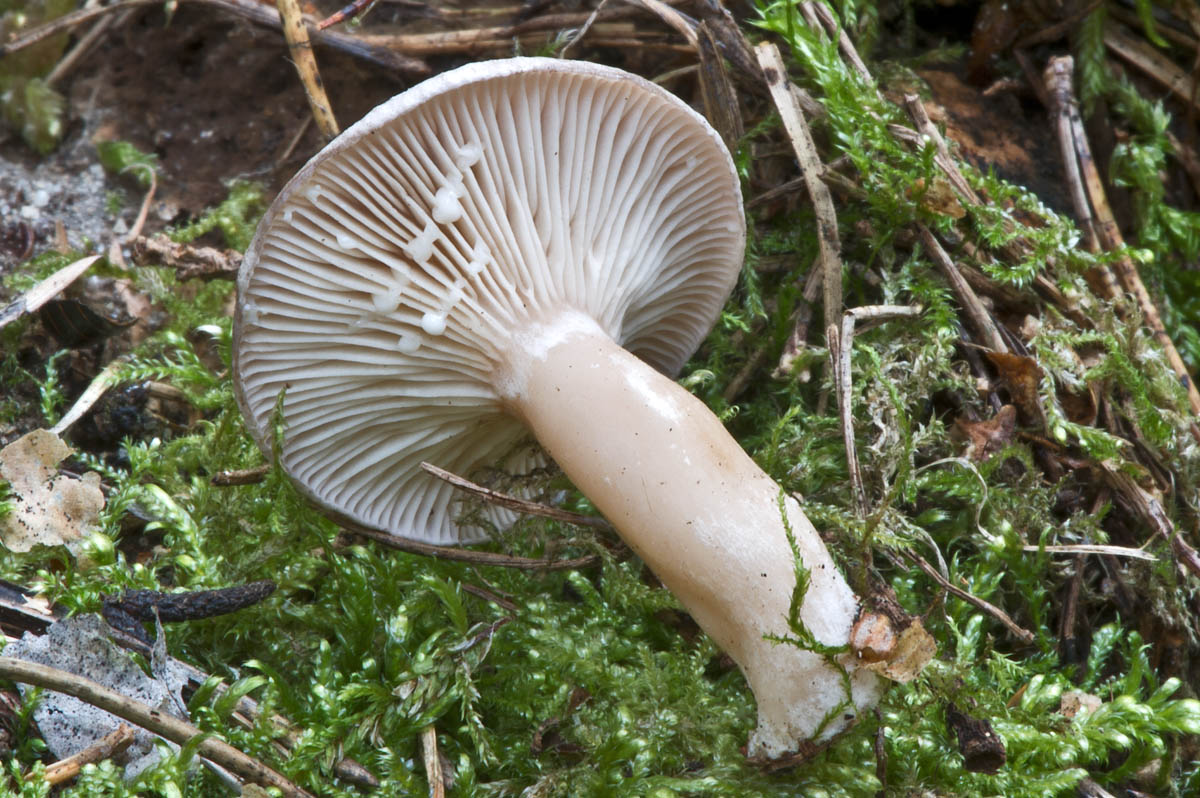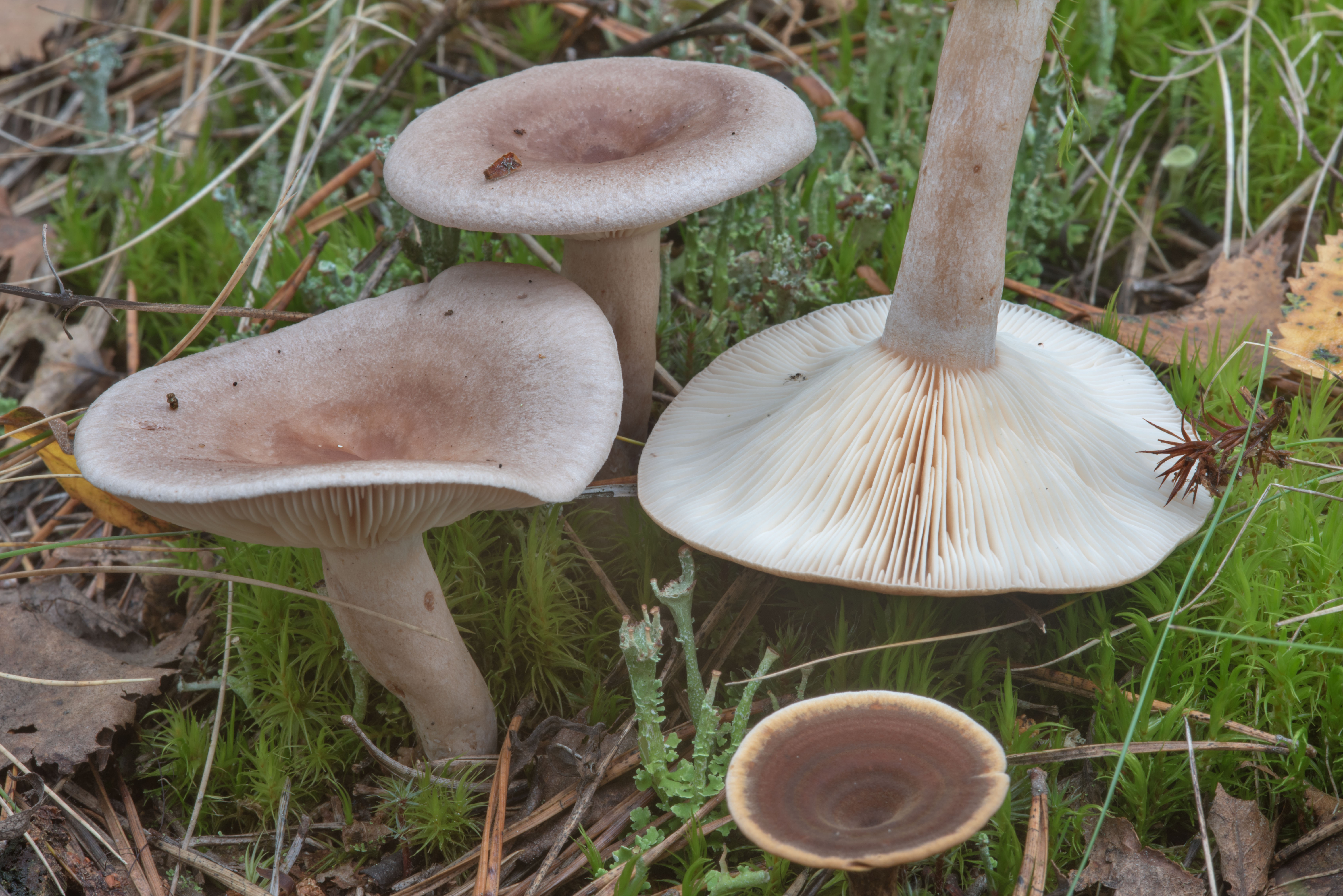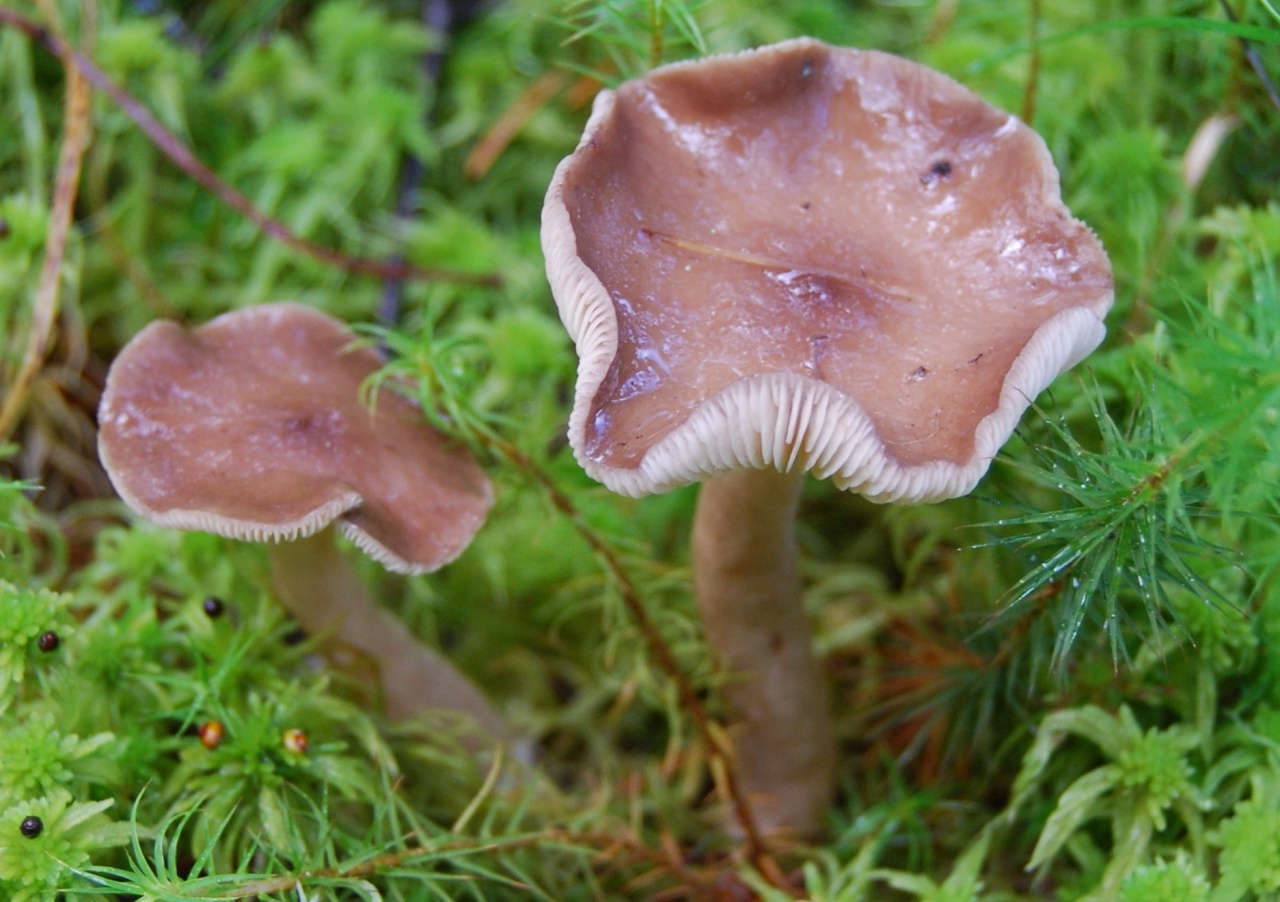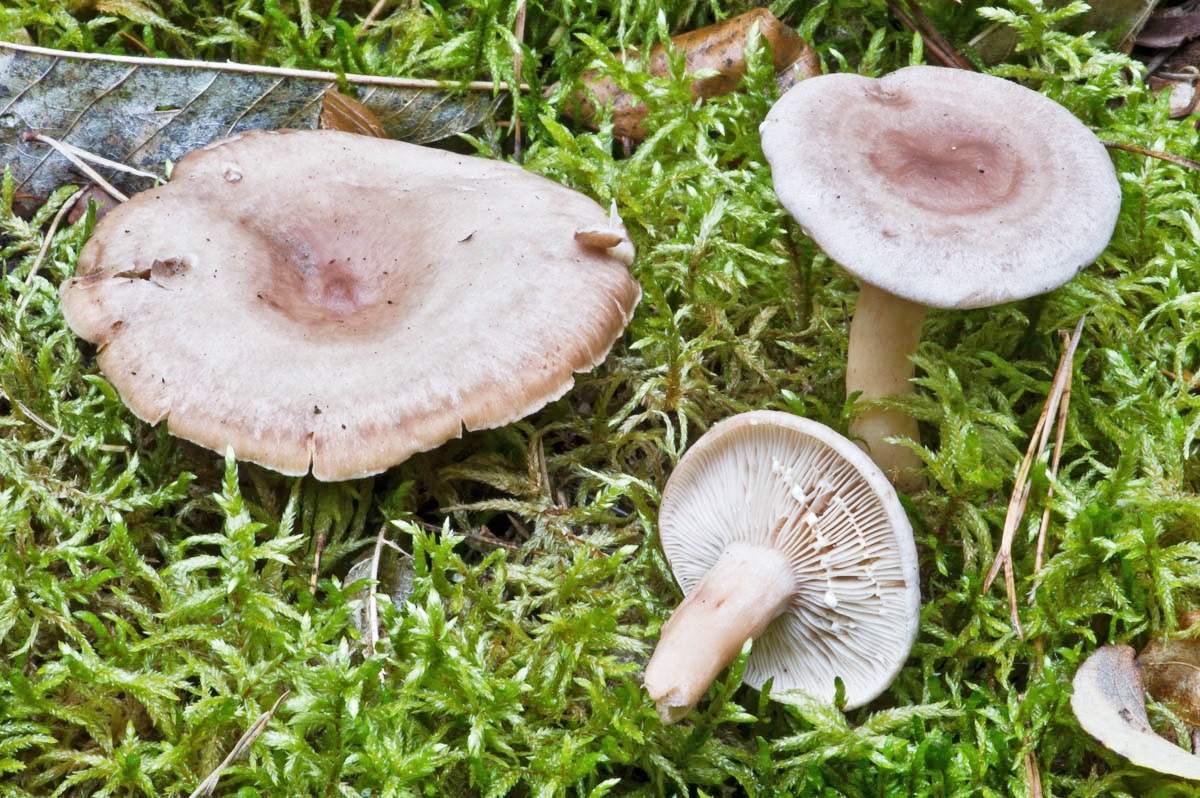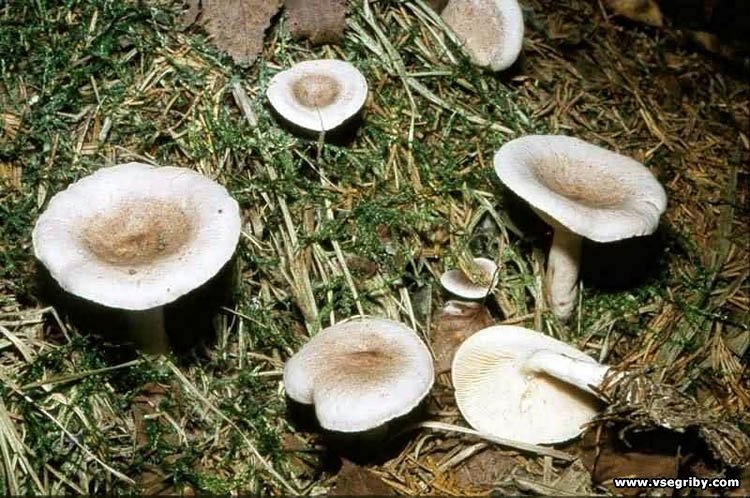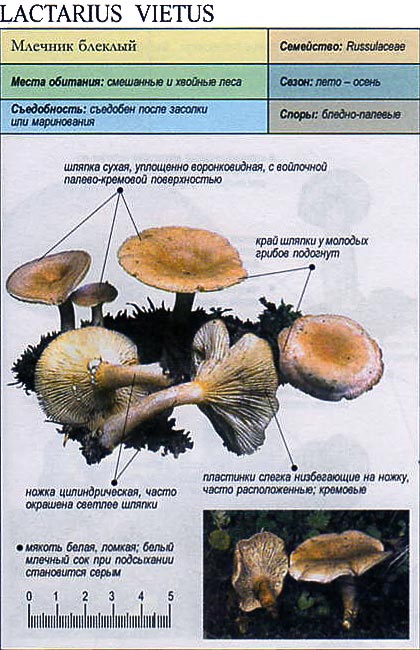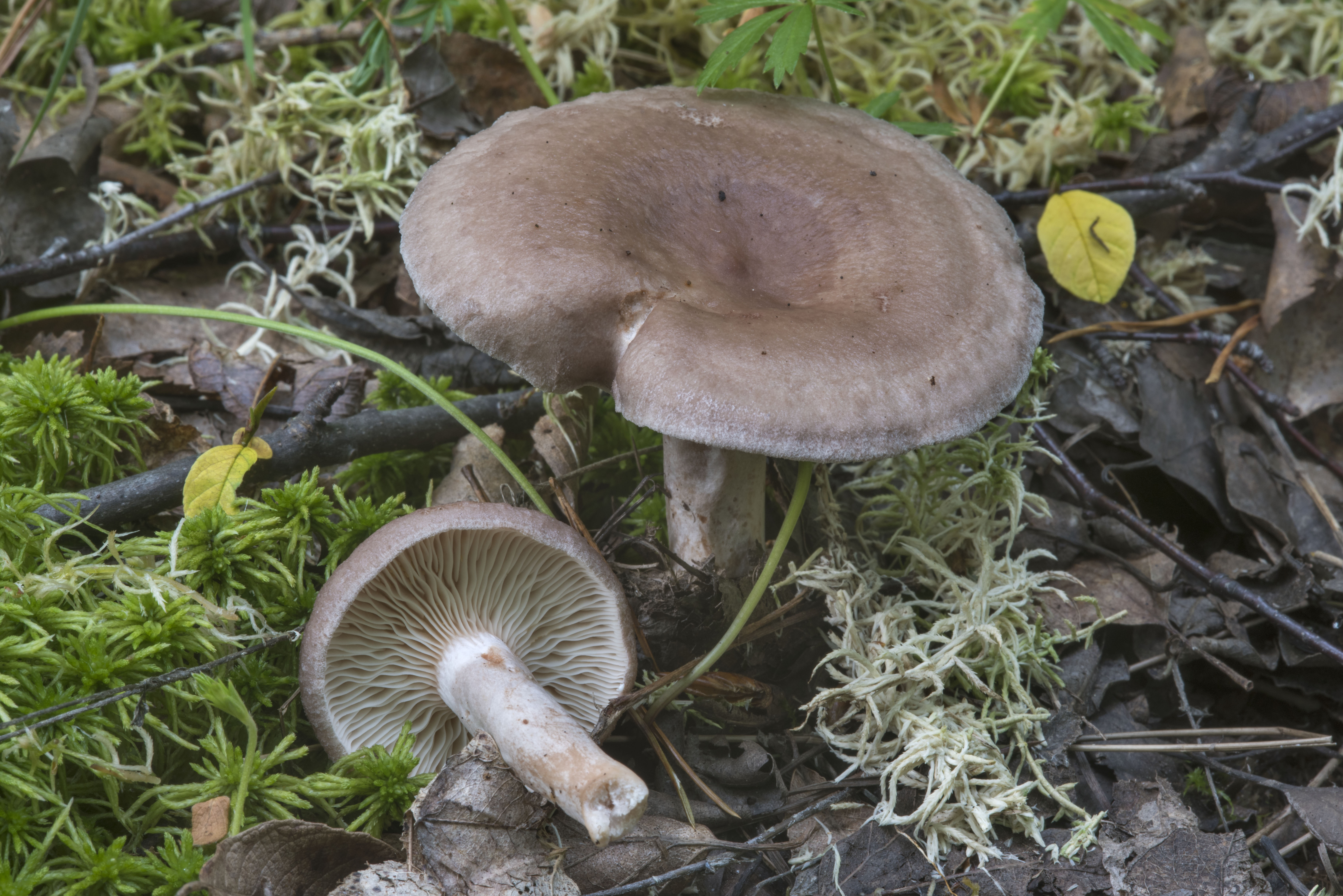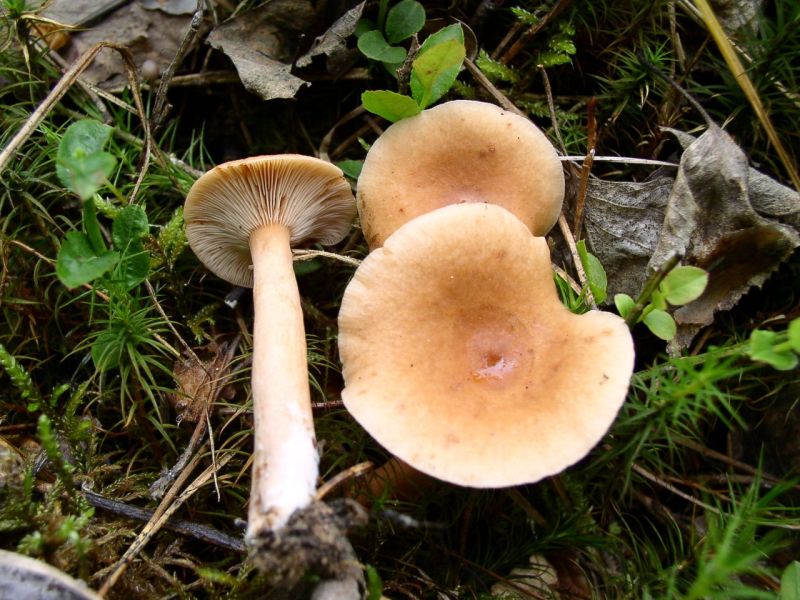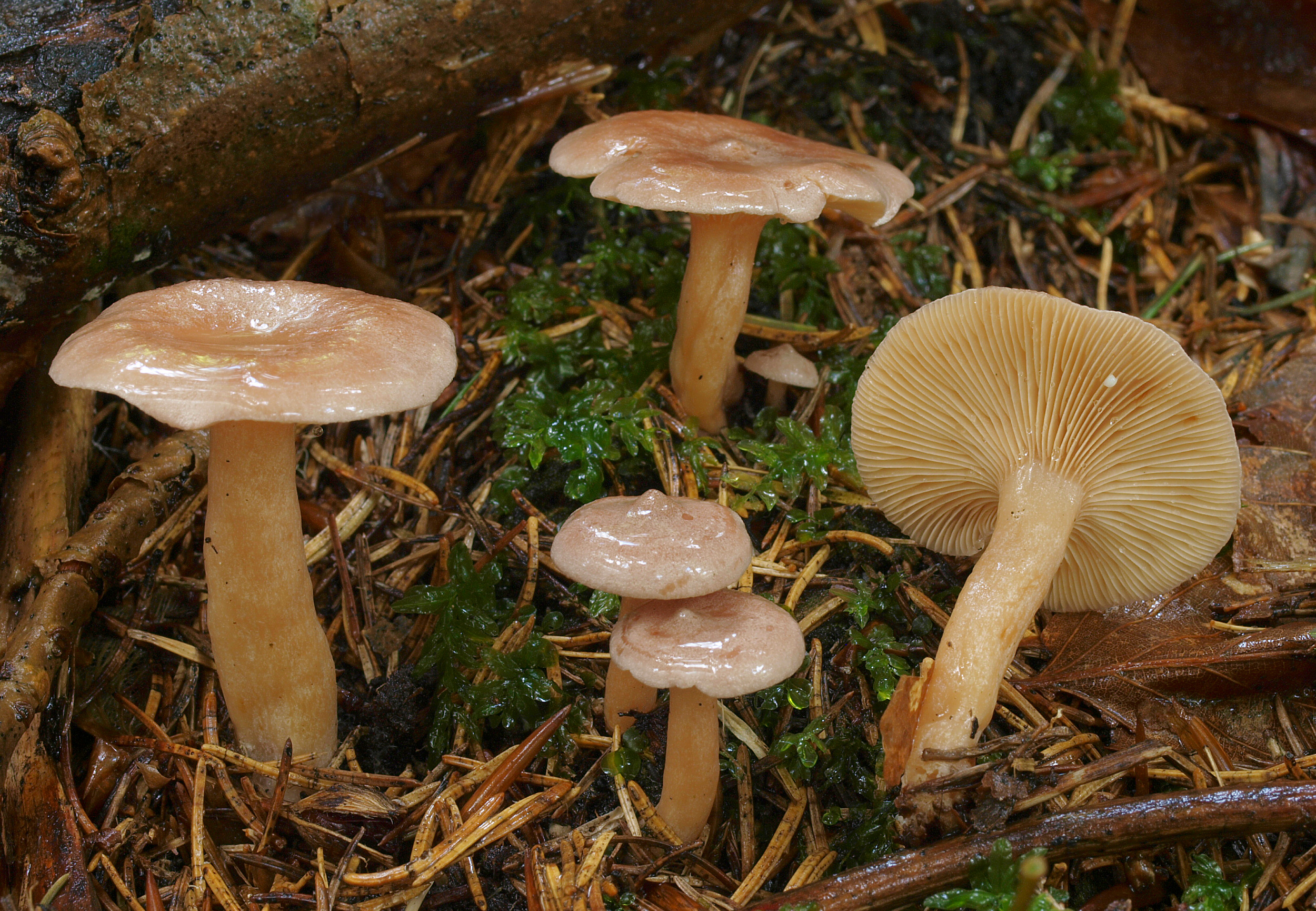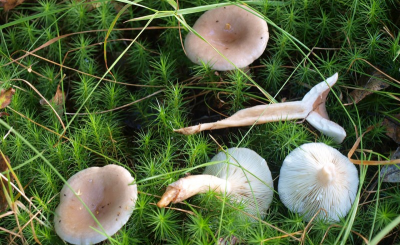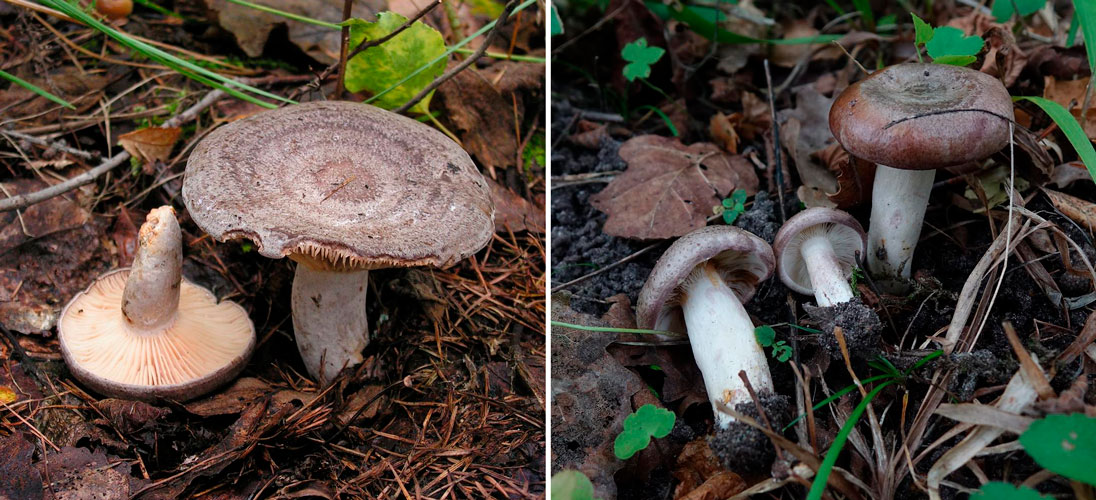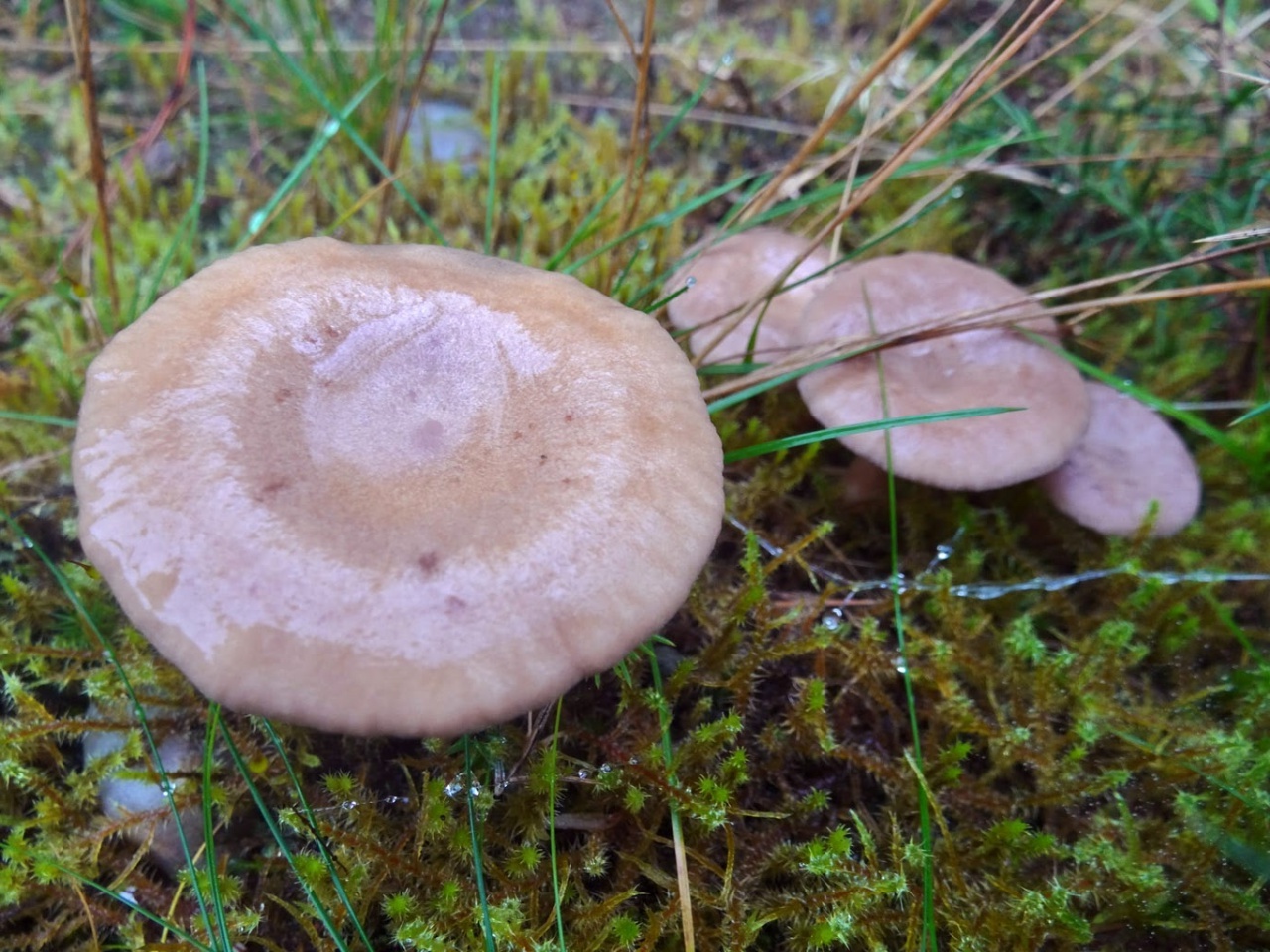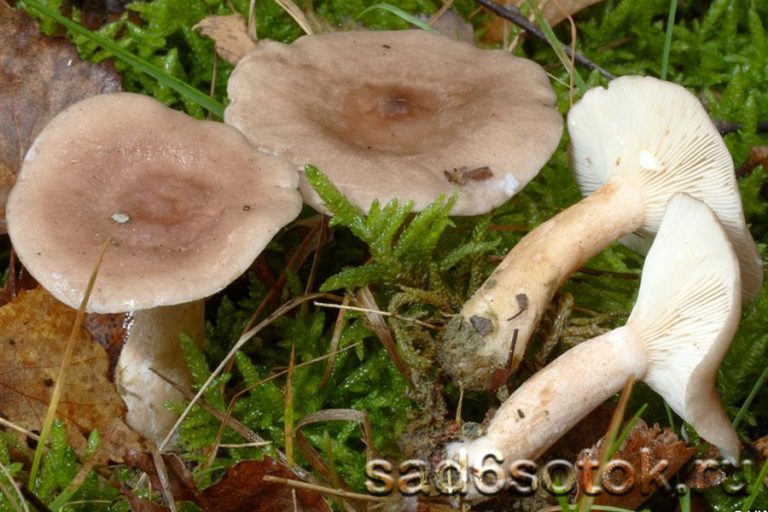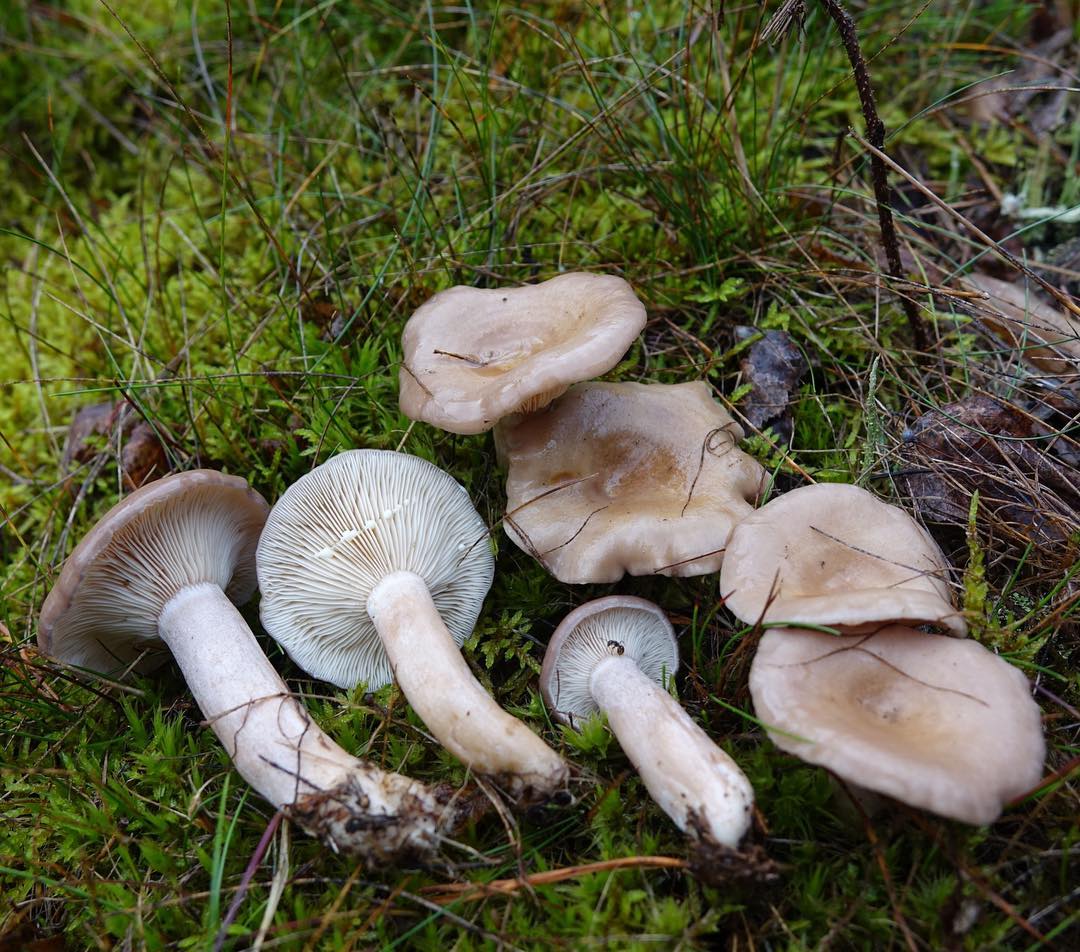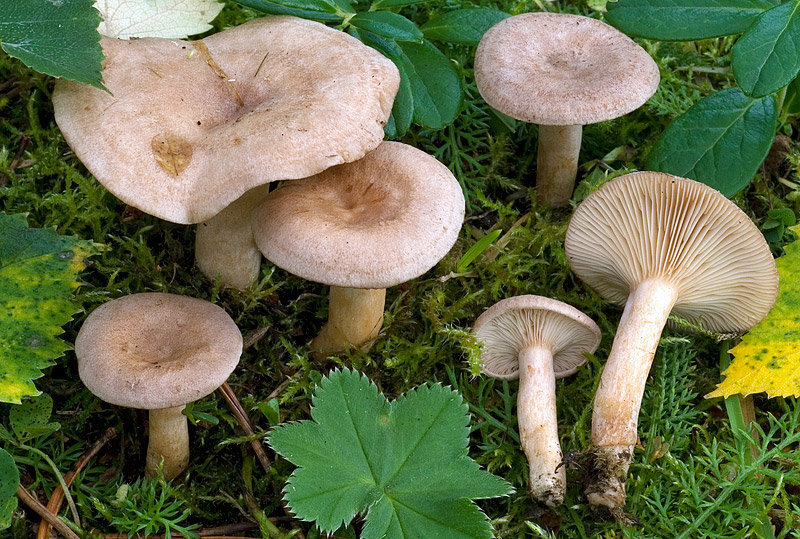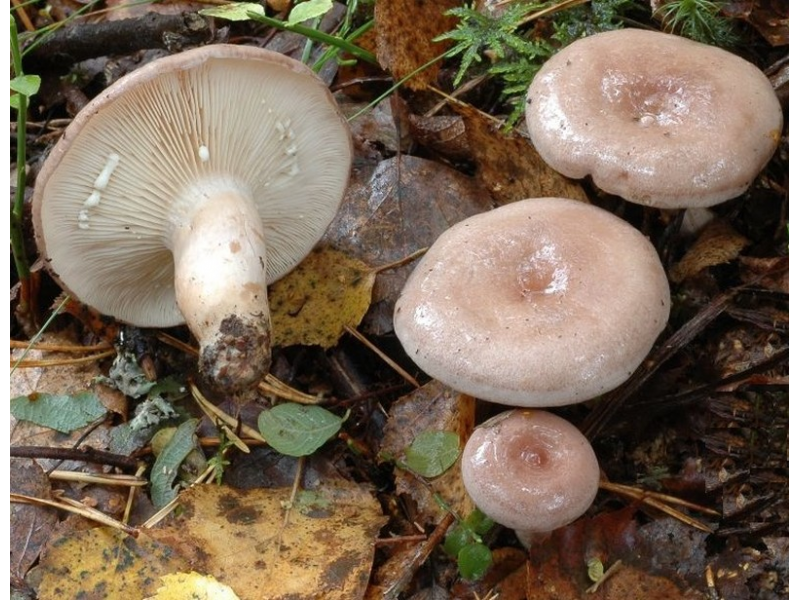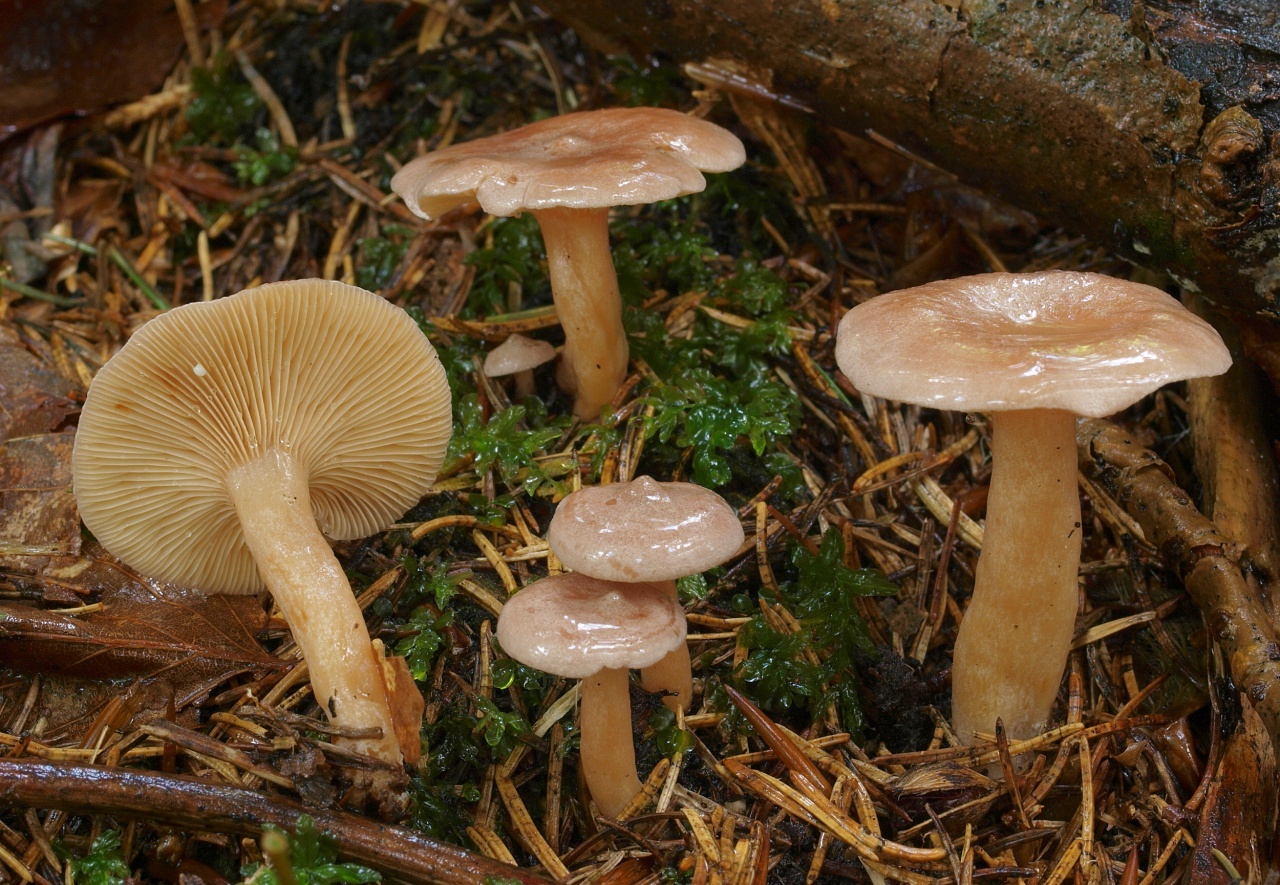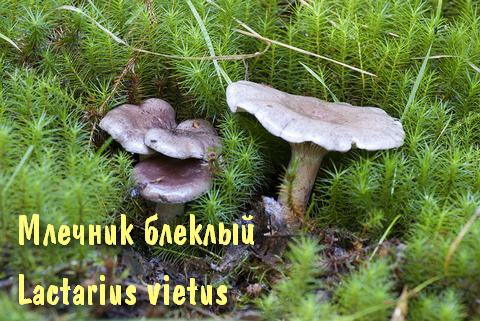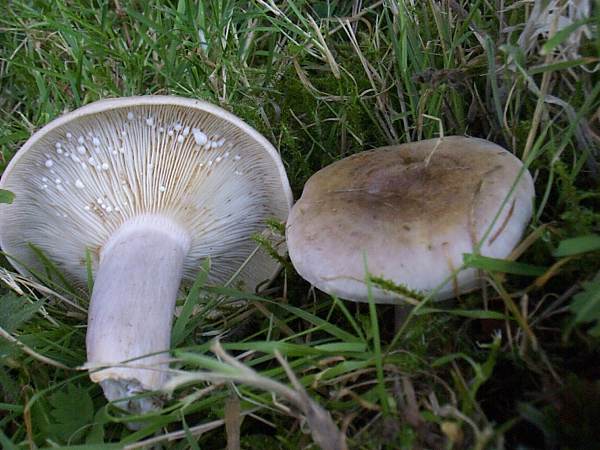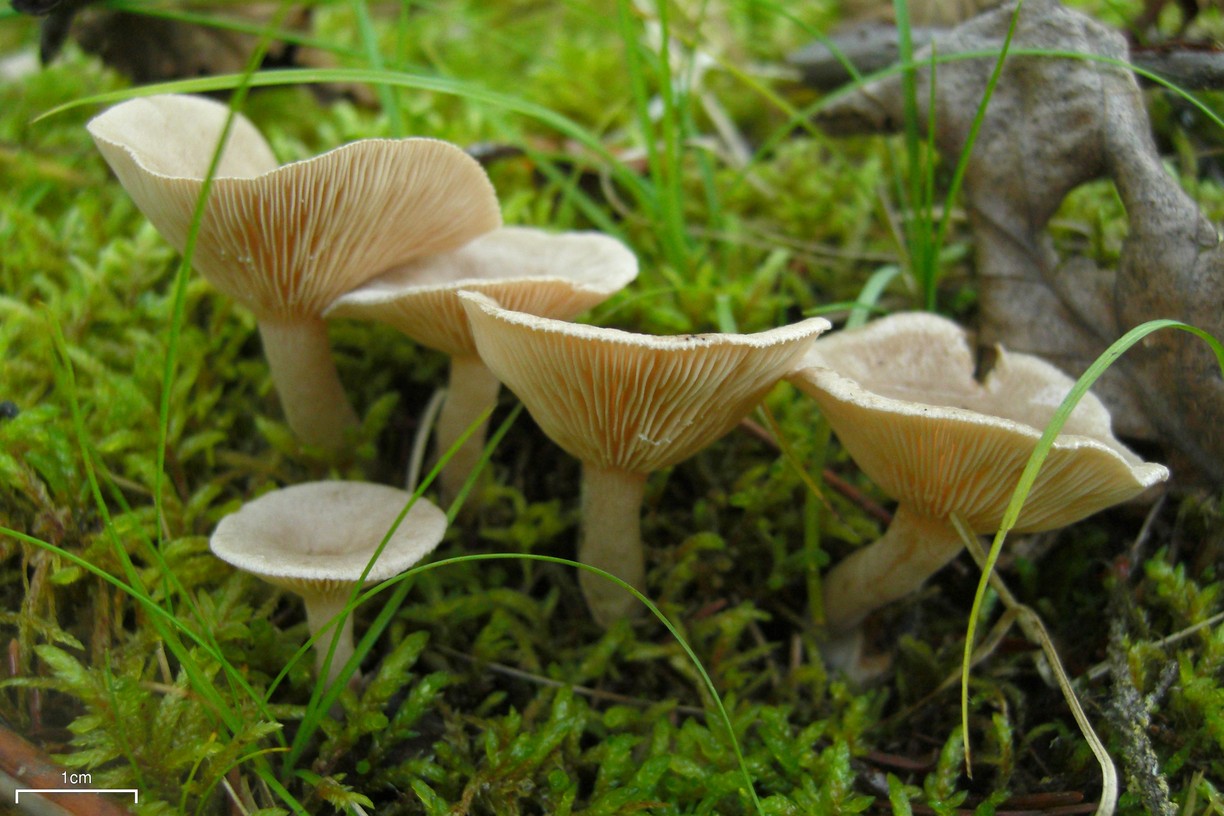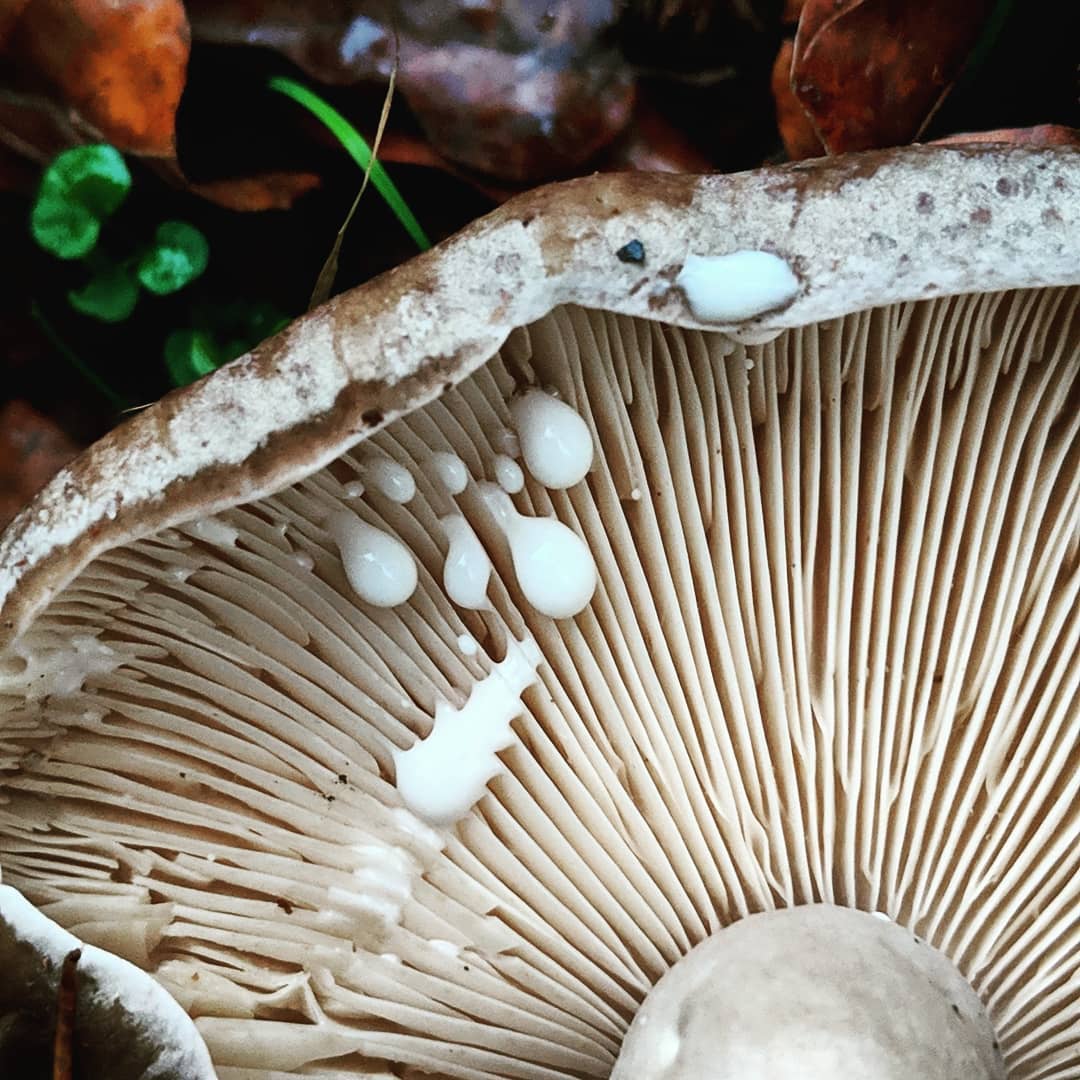Taste qualities of faded milkmen
Mushroom connoisseurs give preference to faded milk-keepers for their excellent taste. But to achieve good taste is possible only with proper processing of mushrooms.
In raw white milkers, the flesh is current, brittle, gray in color, practically odorless, and the taste is bitter. You can get rid of bitterness through special processing. It is best to boil the milkmen, then they can be pickled and salted.
It is believed that the most delicious pale milkmen are salty ones. Before serving, milkers are soaked in salt water to remove excess salt.

Related species
The common milky, like many other lactarius, belongs to conditionally edible mushrooms. The diameter of the cap of the common lactarius is 8-15 centimeters. In young mushrooms, the shape of the cap is irregular, the surface is slimy, the color of the cap is from violet-lilac to pale-brownish. In old milkers, the caps become pinkish-brownish or yellow-lilac.
The plates descend on the pedicle, yellow, often located. The leg length ranges from 5 to 10 centimeters. The shape of the leg is cylindrical, even. With age, the leg becomes hollow. The color of the leg matches the cap.
The pulp is strong, white, spicy with a burning milky juice. The juice turns olive brown when dried. Elliptical spores. Spore powder, cream color.

The papillary milky is a conditionally edible mushroom. The diameter of the cap of the papillary lactic acid is 3-9 centimeters. The shape of the cap is concave or flat, there is a tubercle in the center, the edges are bent. The color of the cap is grayish brown, the surface is dry.
The length of the leg is 3-7 centimeters, the diameter is 1-2 centimeters. The shape of the leg is cylindrical. The surface of the leg is smooth, the same color as the cap. The plates are narrow, whitish in color, slightly descending along the pedicle.
The flesh is brittle, white in color with a slight coconut odor. Ornamented spores. Spore powder of grayish or whitish color. Milky sap is not abundant, white, it becomes dark in air.
Millens papillary grow in deciduous, mixed and coniferous forests. They grow in groups in sandy soil. The papillary lactarius bear fruit from August to September.

Millers are faded and brownish
The faded milky is a conditionally edible lamellar mushroom, in some reference books referred to as a marsh wave or a sluggish milky. Grows in small groups or in numerous colonies from the second half of August to the end of September, invariably giving large yields. Yields usually peak in September. Favorite habitats are areas of mixed or deciduous forests covered with a thick layer of moss, as well as wet areas of soil near swamps.
The cap of the mushroom is convex, with curved edges, but gradually it becomes prostrate-depressed, with a slight bulge in the middle and wavy edges. Its diameter is about 8 cm. The surface of the cap is smooth, damp, after rain it is covered with a thin layer of mucus sticky to the touch. It is painted in a grayish or brownish-lilac color, which in dry and hot summers fade almost to white.
Depending on the habitat, a poorly distinguishable pattern from concentric zones may appear on the surface of the cap in mature mushrooms. The plates are frequent, descending to the pedicle, at first cream, and then yellow. The leg is rounded, sometimes slightly flattened, straight or curved, at the base it can be thinner or thicker, hollow inside, about 8 cm high with a diameter rarely exceeding 0.5 cm.Its surface is smooth, moist, of the same color as hat, only slightly lighter. The pulp is thin, brittle, painted in a grayish color, practically odorless, but with a bitter taste.It produces a pungent milky sap, which, on contact with air, changes its white color to olive gray.
The faded milky belongs to the third category of mushrooms. Perfect for pickling, but requires pretreatment that removes bitterness from the pulp.
The brown miller is an edible lamellar mushroom that grows from mid-July to early October. You need to look for it in dense grass, on soils overgrown with moss, as well as at the foot of birch and oak in deciduous, broad-leaved or mixed forests.
The convex cap of young mushrooms eventually becomes at first prostrate, with a slight bulge in the middle, and then funnel-shaped, with a thin wavy edge. Its diameter in mature mushrooms is about 10 cm. The surface of the cap is smooth, dry, velvety, brown or gray-brown, darker in the center. In dry and hot summers, pale spots may appear on the cap or it will completely fade, becoming dirty yellow. Spore-bearing plates are narrow, adherent, white, which gradually changes to yellow.
The stem is rounded, thicker at the base, hollow inside, about 6 cm high and about 1 cm in diameter. Its surface is smooth, dry, of the same color as the cap. The pulp is soft, firm at first, and then loose, cream-colored, which, on contact with air, acquires a pink tint. It produces a white milky juice, pungent, but not bitter in taste, which quickly turns red in the air.
Brownish milky belongs to the second category of mushrooms, has good taste. It can be eaten without preliminary soaking and boiling. In cooking, it is used to prepare all kinds of dishes and for salting.
Related mushrooms
The main relatives of the faded milkman include:
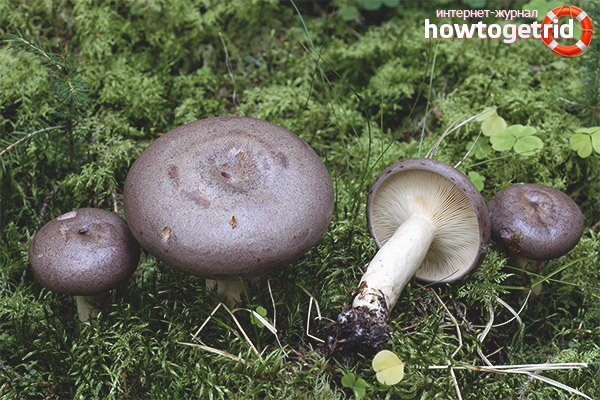
Common miller
The hat in diameter varies between 8-15 cm. In an immature state, it has an irregular shape, there is mucus on the surface, the color of young mushrooms is violet-lilac or pale-brownish. When the mushroom is fully ripe and begins to age, its color changes to pink-brown or yellowish-lilac.
It is also lamellar. His plates are lowered onto a yellow leg. Its height is 5-10 cm. It is cylindrical and even in shape. As it grows old, it becomes hollow.
The pulp of the common lactarius is quite strong and white. When damaged, juice is released, which, after drying, becomes olive brown. The spores of the fungus are elliptical.
Papillary milky
A relatively small mushroom, the diameter of the cap is about 3-9 cm, it is flat in shape, there is a tubercle in the center, its edges are bent. The color of the cap is gray-brown. Unlike a pale and ordinary lactarius, there is no mucus on the surface.
The length of the leg is 3-7 cm, in diameter - 1-2 cm, it has the shape of a cylinder, smooth, the same color as the cap. The plates are narrow, white in color. The flesh of the mushroom is brittle, white and has a mild coconut aroma. The spore powder is gray or white in color. When the fungus is mechanically damaged, it secretes a small amount of white juice, which interacts with oxygen and becomes dark.
This variety can be found in forests, it prefers sandy soil. Harvesting begins in August and ends in September.
Serushka (Lactarius flexuosus)
"Folk mycology" calls many different species of serushki, but science has long reserved this short name for one mushroom. Serushka (Lactarius flexuosus) is probably the most volatile and difficult to formally describe the milkman of this group. At the same time, being "in the field", you cannot confuse a serushka with anything. The characteristic greyish-lilac color of the cap with indistinct concentric zones, relatively rare and thick plates, white, moderately caustic milky juice ... They give out the grayish, firstly, the peculiarities of growth (for this it is called "plantain"): often found on the sides of forest roads , in forest tracks, on clearings and paths.Secondly, it betrays her terrifying tendency to worminess. Serushka forms mycorrhiza with a variety of deciduous and coniferous trees, so you can find it almost everywhere.
For me, Serushka is a stable player in the first league of the milkmen's championship. There are not enough stars, but it does not fall below its level. If it weren't for the sad peculiarity regarding mushroom worms, she could have competed with her older brother for primacy. And so - only the second place.
Millechnik: photo and description of the genus of mushrooms. What do milkmen look like?
Millers are mushrooms with thin or thick fleshy, dense, but fragile fruit bodies, mostly of medium or large size. Their cap and stem are homogeneous (homogeneous) and do not separate from each other without breaking, as, for example, in a champignon. There are stocky mushrooms with a thick stem, approximately equal in length to the diameter of the cap (Lactarius deliciosus, Lactarius pubescens, Lactarius turpis), and there are also species in which a small cap is placed on a long, relatively thin stem (Lactarius camphoratus, Lactarius lignyotus). Both the private and the general veil are absent in fungi of this genus.
The cap of the lactarius can be funnel-shaped, depressed, convex-outstretched, or convex. In young mushrooms, it is straight or convex with the edge tucked down. White or brightly colored (yellow, orange, gray, pink, brown, blue, purple, olive-black), with a wavy, straight or ribbed edge. With age, some mushrooms change the color of their fruit chalk.
The surface of the lactic cap is dry or slimy, smooth, scaly, fleecy or velvety, monochromatic or with concentric circular zones and grooves - lacunae. The size of the cap is from 8 to 40 cm (Lactarius vellereus). In a stunted lactarius (lat. Lactarius tabidus) and a dark lactarius (lat. Lactarius obscuratus), the cap is capable of swelling, absorbing water.
The miller is stunted.
The flower is pink.
The hymenophore of these fungi is lamellar. The lamellar plates descend to the pedicle to varying degrees, attaching to it strongly in some species, insignificantly in others. Plates with anastomoses or notched, are both white and colored in bright colors: pink, bluish, pale ocher, cream. Can change color when touched. For example, the plates of the lilac lilac (lat.Lactarius violascens) are initially white or creamy yellow, when squeezed they turn purple.
Spruce ginger.
A characteristic feature of the lactarius and russula in general is the net pattern on their spores. The cells themselves, intended for reproduction, are more often spherical, broadly oval or oval in shape. Spore powder is white, ocher or yellowish cream.
Spores of the aromatic lactarius under the microscope.
The leg of the lactarius is attached to the cap in the center; its shape is regular cylindrical, flattened or narrowed towards the base. It is white or the same color as the cap, sometimes hollow inside, often with chambers or full. The surface is smooth, dry, less often slimy and sticky.
Some species have depressions (lacunae), colored somewhat darker than the rest of the skin of the leg. The height of the leg of the lactarius is 5-8 cm, its diameter is 1.5-2 cm.
Miller is neutral.
The pulp of the lactarius is fragile, white or with a brownish, creamy or fawn tint. It can change color when exposed to air. It contains conductive thick-walled hyphae with milky juice.
The color of the milky sap and its change in air are an important systematic sign by which the species of the genus are distinguished. Most often it is white, but in some species in the air it slowly turns green, gray, yellow, becomes purple, red, etc. In the North American blue milkman (Latin Lactarius indigo), the juice, like the entire fruit body, is blue.
Bitter.
The blue milkman.
Useful properties, medical applications and restrictions on use
Milk mushrooms have long been used in folk medicine for the treatment of purulent wounds, kidney diseases and other diseases.Most of the species have anti-tumor and antibacterial effects. The fruit contains vitamins that have a beneficial effect on the nervous system and prevent the development of sclerosis.
Lactose
Medicines made on the basis of milk mushrooms help cope with kidney stones. The blue milk mushroom contains a natural antibiotic that has a detrimental effect on staphylococci. In some fruits, scientists have discovered lactarioviolin, an antibiotic that helps to destroy the pathogens of tuberculosis.
Most of the mushrooms of this genus are conditionally edible fruits, so they need to be heat treated before eating. You cannot harvest near highways, factories and plants, it is better to do this in ecologically clean areas. It is not advised to eat these fruits for gastrointestinal diseases, pregnancy and breastfeeding.
Recipes and cooking features
Mushrooms of this kind can be fried, boiled and pickled, but in this form their taste is muted. Salty and fermented milkers are characterized by good taste. Ryzhiks do not require prolonged soaking, but bitters, milk mushrooms and waves should be soaked for a while in cold water.
Here are some delicious recipes:
- If the basket is filled with mushrooms, this is a great reason to please loved ones with fried mushrooms. The crop is washed and cleaned from forest debris. Each copy is cut into 5-7 pieces and laid out in a preheated pan with sunflower oil.
Fried mushrooms The fire should be medium so that the water from the mushroom mass evaporates faster. When the water has boiled off, reduce the heat and fry for about 15 minutes. At this time, you can add finely chopped onion, salt and fry for about another five minutes.
- To prepare delicious Korean mushrooms, you will need the following ingredients:
- milkmen (any bitter mushrooms);
sugar;
soy sauce;
table vinegar;
fresh garlic;
hot pepper;
ground coriander.
Millers in Korean
The fruits are pre-boiled 2-3 times for 30 minutes, each time changing the water. It is desirable that a slightly bitter taste remains in them, which will give the dish a special piquancy. Boiled fruits are seasoned with soy sauce, sugar and a little vinegar are added. The resulting mass is thoroughly mixed with the addition of the necessary spices. The finished dish should be allowed to brew for several hours in the refrigerator.
Description of the faded milkman
The faded miller combines all the features inherent in this genus. The cap of the lactarius is of a faded convex shape, its edges are slightly bent. As it ages, the cap opens and becomes slightly depressed, and the edges become wavy. The maximum size of the cap reaches 8 centimeters, that is, these are rather large mushrooms.
The outer layer of the cap is slightly smooth, with a slight bloom of mucus. The mucus protects the fungus from drying out. The inner side of the cap is lamellar. The plates are cream-colored, they descend mutely on the leg.
The leg of the lactarius is faded with a round shape, sometimes it is slightly flattened. Depending on the places where the mushrooms grow, it can be curved or, on the contrary, even. The leg bends as the milkmen have to fight their way through a thick layer of moss. Inside, the leg is hollow, it tapers slightly downward. The leg can be up to 8 centimeters long with a diameter of only 0.5 centimeters. The leg, like the cap, is covered with a layer of mucus. The color of the leg is slightly dimmer than the cap, but of the same tone.

The pale milky differs from its congeners in color. The hat is gray-lilac or brown-lilac. The color depends on the age and place of growth. In very hot weather, the milkmen are faded; in general, they change color to almost white. Rarely is a mushroom decorated with a faint, almost indistinguishable pattern. If the lactic acid is damaged, a very caustic sap of white color comes out of it; upon contact with oxygen, it becomes grayish.
Places and times of collection of faded milkmen
These mushrooms appear in the forests at the end of August and are harvested by the end of September.Faded millers give large yields, but they grow in small groups.
They grow in humid forests, so you should look for them near swamps. In addition, they inhabit mixed and deciduous forests, which have dense moss that retains moisture well.

Common miller
The common milky (Lactarius trivialis) is the undisputed leader among the gray lactarius. It was about him that was discussed at the beginning of the article. He, and only he, out of all the gray mass, is able to challenge the mushroom elite - a load of white and black. Yes, not only to challenge, but also to win. Even if only in someone's eyes.
And here he is, our hero (photo by I. Lebedinsky)
Common millechnik (it is also called a "hollow" for a hollow leg) is a favorite mushroom of the north - Russian and not only. Very much appreciated in Finland. By his standards, we have the extreme south, and he doesn't look here often. Although, I remember, somewhere in the north of the Moscow region, or even in the south of the Tverskaya region, I collected it on an industrial scale. Finding it can be difficult. This king-milkman is rare, he prefers damp windbreak forests, the borders of swamps, where it grows in cooperation with birch and spruce. It is not easy to find, but once you have found it, it is even more difficult to carry it away! They write about such mushrooms: rarely bears fruit, but abundantly. As, in fact, a real lump.
Most of all, the "nesting house" resembles a large serushka of the correct shape (that one is usually clumsy). A large, strictly round cap with a central indentation is colored in all shades of gray-violet; the short thick leg is always empty inside. Moderately caustic juice is first white, then gradually turns green.
I typed it only once. In cold salting (without soaking), he first surprised me with a beautiful yellow color, and then with a very delicate, delicate taste. It was a long time ago. I could be wrong. But, perhaps, one could agree with that peremptory reader. A very special mushroom. And almost never wormy.
But it does not grow with us. Doesn't grow. Grunt, cry, ruffle a painful beard, and return to your milk mushrooms and mushrooms.
... Or is it growing? Tell me, are you growing? Maybe you are growing?
How to salt smoothies with spices
This recipe uses cooking and spices. This makes the appetizer even more interesting. You will need:
- 2 kg of mushrooms;
- 100 g of salt;
- 4 cloves of garlic;
- greens or dill umbrellas;
- black currant leaves;
- casting horseradish;
- oak leaves.
- Rinse the milk jugs, cut the legs short, put in a saucepan, cover and leave for 24 hours. Rinse the mushrooms and change the water twice during this time.
- Pour the workpiece with clean water and cook it for 15 minutes. Let cool without draining the water.
- Rinse the enamel pot well and scald with boiling water to kill germs.
- Place all the washed leaves and dill at the bottom of the pot. Layer the mushrooms, sprinkle with salt and garlic chunks. At the end, add another layer of leaves.
- Cover the workpiece with a plate, place a weight on it and put the pan in the refrigerator. The temperature should be no higher than 10 ° C. Salt the mushrooms for 30 days.
The ready-made appetizer can be served for a festive table or for an everyday homemade dinner. Also, salted milk jugs can be used as an ingredient for salads.
Such mushrooms are rare, but if you managed to find a mushroom, take a close look, they usually grow in large groups. Find such a group and you can pickle several cans of delicious snacks.
The lactic family is widespread and diverse. Its representatives have several features: they are rarely affected by larvae, they bear fruit in late autumn, when other mushrooms have moved away. This family also includes the smooth mushroom. Large and fleshy, it invariably attracts lovers of quiet hunting.
Harm and contraindications of milkmen
You must not pick and eat mushrooms that grow near highways, garbage cans and enterprises that pollute nature. The fact is that any mushrooms absorb harmful substances and heavy metals. Accordingly, they can be harmful to health.
Conditionally edible milkmen cannot be eaten without preliminary processing - soaking, boiling
This is done to remove the bitter milky juice, which, if it enters the human digestive system, can cause eating disorders.
All mushrooms should be eaten in small quantities, and for diseases such as pancreatitis, stomach and duodenal ulcers, gastritis, liver failure, cirrhosis of the liver, hepatitis, they should be abandoned altogether.
Lacticians are eaten with caution during pregnancy and lactation. Mushrooms are contraindicated for small children.
Salted mushrooms should not be eaten with hypertension and kidney disease, as this threatens to disrupt the water-salt balance.
The gingerbreads are real.
Mushroom common lactarius and its photo
Category: conditionally edible.
Lactarius trivialis cap (diameter 5-22 cm): shiny even in dry weather, with dark rings. Changes color and shape depending on the age of the fungus: in young mushrooms, it is dark and gray-gray, rather convex; in old ones, purple and brown, and then ocher or yellow, flatter and even depressed. Dense, maybe with small dimples. The edges are wavy, curved, often curled inward.
Stem (height 4-10 cm): pale gray or light ocher, cylindrical, sometimes swollen, but always hollow. A bit slimy and sticky.
Pay attention to the photo of an ordinary milkman: its plates are frequent, thin (occasionally wide), mostly yellow or cream in color, with rusty spots. Pulp: thick and fragile
Mostly white, but brownish under the skin itself, and red at the base. Milky sap is very bitter; when interacting with air, it changes color to yellow or slightly greenish. Has a peculiar smell reminiscent of fishy
Flesh: thick and fragile. Mostly white, but brownish under the skin itself, and red at the base. Milky sap is very bitter; when interacting with air, it changes color to yellow or slightly greenish. Has a peculiar smell reminiscent of fishy.
Doubles: none.
When it grows: from mid-July to late September.
Where to find it: In humid places and lowlands of all types of forests, most often near pines, spruces and birches. Hides in dense grass or moss. An ordinary milkman is not afraid of pests.
Eating: fresh or salted, subject to pre-soaking to remove bitterness. When cooking, it changes color to bright yellow or orange. It is very popular in preparations for housewives in Finland.
Application in traditional medicine: not applicable.
Other names: gladysh, alder, nest, yellow nest, gray lump.
Faded milky: photo and application
Category: conditionally edible.
Faded lactarius cap (Lactarius vietus) (diameter 4-9 cm): gray, lilac, lilac or gray-brown, eventually fades to white or grayish. Slightly convex or outstretched. The center is slightly depressed, but with a slight tubercle and usually darker than the edges, which are curved towards the inner side. The surface is often uneven. Sticky and damp to the touch, with sticky twigs or leaves.
As you can see in the photo, the faded lactarius has an even, sometimes slightly curved leg. Its height is 5-9 cm. The color is white or light brown, lighter than the cap. The shape is cylindrical.
Plates: thin, narrow and very frequent. Cream or ocher in color, gray at the point of depression.
Flesh: white or gray, with a pungent milky juice. Thin, very fragile.
Doubles: none.
When it grows: from mid-August to early October.
Where to find: in deciduous and mixed forests, especially near birches. Prefers damp and swampy places.
The use of faded lactarius in cooking is limited - since the flesh of the mushroom is very thin, it is not very popular. Only the largest specimens are salted and pickled.
Application in traditional medicine: not applicable.
Other names: sluggish milky, marsh wave.
Brownish milky
- The mushroom is classified as conditionally edible. The top reaches a maximum of 12 cm in diameter, but there are specimens of 5-10 cm on average. The hat is colored with a chocolate shade, it quickly breaks. The edges are bent, the top itself becomes depressed over time. Feels like velvet.
- The base can be up to 11 cm long. It is colored brown, beige or white. The format is cylindrical. The plates on the inside of the hat are closely spaced, colored with ocher or pink pigment.
- The soft part breaks quickly, it is very fragile and white. If you make a cut, then when weathered, the pulp will change and become pinkish in this area. Smells delicious berries, no bitterness. It is necessary to search for copies in Europe. They bear fruit from mid-summer to early autumn.
- This mushroom is considered conditionally edible, as it is eaten more often than other varieties. The specimens are salted and dried. However, such mushrooms are consumed in the vastness of our homeland, in European countries they are not eaten.

